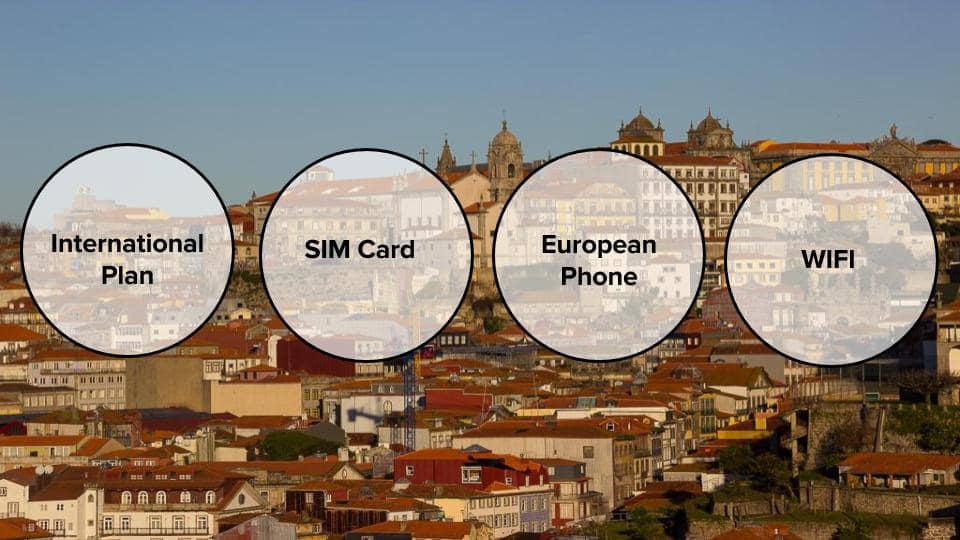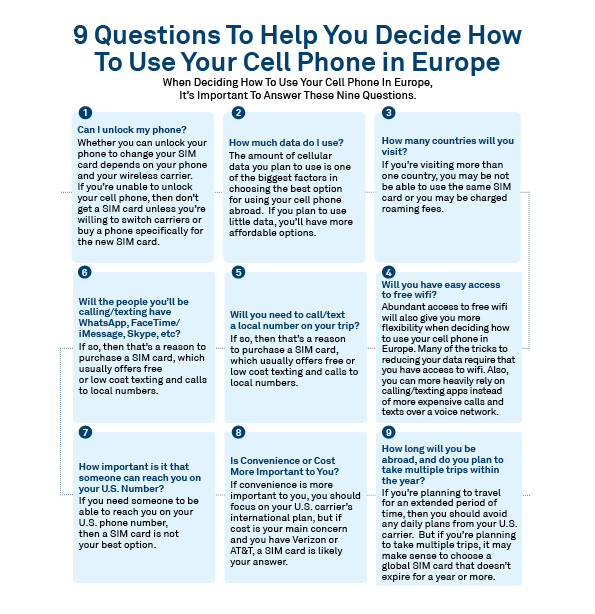
You have a U.S. cell phone and plan to travel to Europe soon. You don’t love the idea of spending half of your time looking for free wifi. You want to be able to wander the streets of Paris thanks to Google Maps or post real-time shots of your tasty gelato in Rome on Instagram.
This guide provides detailed summaries of each option for using your cell phone in Europe and will walk you through how to choose your best option and the process to get sorted.
Option 1: The International Plan Offered by Your U.S. Cell Phone Carrier
If there’s no wifi, your smartphone must use cellular data to connect to the internet, and if you don’t use an online service like Skype or WhatsApp, your smartphone must use a voice network to call home. If you keep your U.S. wireless plan when using the internet and making those calls, you may be charged roaming fees to use another carrier’s tower whenever you’re off wifi. That’s as much as $2/minute for calls and $2/MB of data!
U.S. wireless carriers, however, have begun offering more competitive international plans and some even provide free international roaming. So in deciding how to use your cell phone abroad, start by reviewing the international plan offered by your existing U.S. wireless carrier. Whether you keep your cell phone carrier for your trip to Europe will depend on which carrier you have and your answers to the nine questions at the end of this post.
Option 2: Replace Your SIM Card
A SIM card is a small card containing a chip that allows your cell phone to tap into a specific mobile network. You can remove the SIM card from your U.S. wireless service carrier (Verizon, AT&T, etc.) by inserting a pin or paper clip into the small whole on the side of your phone and replacing it with an international SIM card. When you take out your U.S. SIM card, you’ll get a new number from the country where you purchased the card, and you’ll be unable to call or text with your U.S. number. But you’ll usually pay significantly less for cellular data using a local SIM card, and you can connect with those in the U.S. using online calling and messaging services such as Skype, WhatsApp, and iMessage/FaceTime (see here for a comparison of top wireless calling apps). SIM cards also may provide better coverage than if you use the international plan of your U.S. carrier if you’re using T-Mobile and Sprint’s 2G networks.
When deciding whether to get a new SIM card, you should review your answers to the nine questions at the end of this post and this detailed article on whether to buy a SIM card, which includes a comparison chart of popular offerings, useful tips on where and how to buy SIM cards and helpful checklists for buying either a local or global SIM card.
**In June 2017, the EU implemented the “roam like at home” rule, which prohibits providers from charging roaming fees. If you buy a SIM card in one EU country and travel to another EU country, you cannot be charged a roaming fee. This has made global SIM cards less appealing, but there may still be reasons to get a global SIM card.

Option 3: Buy or Rent a Separate Phone
If you’re only taking a short trip buying or renting a separate cell phone in Europe makes little sense unless you go to the country frequently enough to justify the upfront cost (at least $20-30 for a crappy phone) or you have an old phone you can use, and you’re able to easily add your contacts. You’ll still have to pay for a new SIM card, but you can leave your primary phone as is and receive calls texts to your U.S. number in an emergency if you’re willing to pay the roaming charges or for the international plan. It also makes sense if your phone is locked. In which case, you can’t replace your SIM card (find out how to unlock your smartphone).
Option 4: Rely only on Wifi
On our trips to the Middle East and India eight plus years ago, we did nothing. We kept our U.S. wireless carrier but turned our phones to airplane mode and relied on wifi and Skype to call home. This is no longer a good option for the Travel Honey team and most of our readers. If we’re using our cell phone in Europe, we want to be able to get directions, text home and obviously let the world know about our cool trip on social media. In real time.
But for those who are more willing to unplug, just beware. If you have Verizon or AT&T, and need to use your phone in a pinch, a two-minute call will run you $40 on AT&T and $35.80 on Verizon. Also, before landing in Europe, make sure you turn cellular data and roaming off or put your phone to airplane mode so you are not charged roaming fees.

SO, HOW DO YOU DECIDE HOW TO USE YOUR PHONE IN EUROPE?
To sum it up, if you’re trying to use your cell phone in Europe, don’t rely on wifi, that’s an unecessary inconvenience. And if you’re going for a short trip, skip using another phone. Instead, evaluate the cost of your U.S. wireless carrier’s international plan and the inconenience of getting a SIM card.
Do you want to learn more about using your cell phone in Europe, including whether to get a SIM card, 14 tips for saving data when traveling, what’s the best calling app and how to use offline maps? Then click here for links to all these articles.
Or get the guide in one easy to read PDF. We just need your email below. You may also like one of our awesome itineraries for France, Germany, Budapest, Iceland, Italy, Portugal, Spain or the United Kingdom.
At Travel Honey, we find savvy travelers and share their trip recommendations with you through awesome guides and interactive maps. We provide all the information you need in one place, give you trip advice you can trust, simplify logistics, and save you time.


